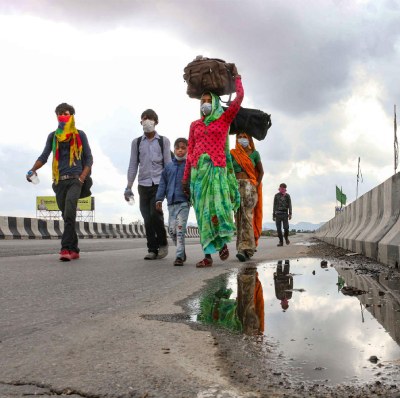
Bangalore’s Informal Labour Markets
- By H. S. Ranjini Rao--
- May 19, 2020
Informal Labor, Reverse Migration, Bangalore
Background: The city of Bangalore’s usually is home to about 42 Lakh migrant laborers, about 44% of its total population. They are employed in the manufacturing and construction industry, in small restaurants and automotive industry and about 50% of the migrants work as contractual laborers. These sectors seem to be the worst hit due to the lockdown and the reverse migration of migrants from various parts of the city to states like Bihar, Odisha, Jharkhand and Madhya Pradesh, among others. As a result, nearly 2.08 lakh workers recently surveyed are keen on leaving for their native places as they face lack of employment, food and social security with uncertainty over when economic activity will re-start in the city.
Status of Migrant Labor: So far 1,22,515 migrant laborers have left the city; 53000 migrants through Shramik Special trains and an additional 69,515 through KSRTC buses. With many more walking and others status undocumented, an upper bound of about 4 lakhs migrants or about a tenth of the workforce exiting is reasonable estimate. A further group of laborer are stranded and await opportunities to leave - over 1,700 Metro workers are waiting to be return home at various construction sites; 70,000 workers associated CREDAI and over 1,000 workers are stranded at Amrutahalli in BOCW sheds (Building and Construction Workers). Separately, nearly 7.75 lakh cab and auto drivers in the state are facing unemployment and have been supported with Rs. 5,000 each under the relief measures announced by the CM. 2.5 Lakh garment workers continue to live at subsistence levels without work across the city. This is what we know – what we do not know involves the status of street vendors and domestic workers and other who largely remain unregistered and not connected to social security and employment protection and heavily depend on word-of-mouth basis employment. Many migrant laborers are now pushed towards poverty and must be accommodated within the relief schemes.
Policy response: With more than 35 Lakh migrant workers within the city out of work and informal labor widely used in different industries and economic settings there is both a humanitarian and economic justification to immediately find ways to re-employ them. GoKarnataka is making special efforts to bring back workers to Bangalore. Those registered on the Seva Sindhu Portal (26,000 workers to Bangalore Urban and 5,000 workers to Bangalore rural) have been reached out to. Spread out across the states of Bihar, Maharashtra, Rajasthan, Tamil Nadu, Andhra Pradesh this is a big exercise. Further, there is an attempt to facilitate the search for employment through the Kayaka Mitra mobile application. To tackle the large reverse migration and create employment in rural areas, the government has targeted creation of 13 crore person days job under MNREGS this financial year. In this light there an urgent need to consider an urban counterpart to MNREGS to push the economy towards a new normal.
Data Sources:
Deccan Herald (5th May – 12th May)
Rough estimation of 1000 passengers per train is in place wherever data on passengers is missing. https://www.newindianexpress.com/states/karnataka/2020/mar/29/4-days-100km-labourers-trudge-from-goa-to-ktaka-2122834.html












































































H. S. Ranjini Rao